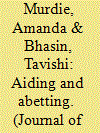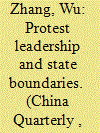| Srl | Item |
| 1 |
ID:
104040


|
|
|
|
|
| Publication |
2011.
|
| Summary/Abstract |
This article studies the effects of human rights international nongovernmental organizations (INGOs) on domestic antigovernment protest. Unlike mainstream scholarship, the authors argue that human rights INGOs are not simply the magic bullet in orchestrating nonviolent protests; different types of human rights INGO activity have varying effects on protest. Moreover, some human rights INGO activities may lead to higher levels of violent protest. The empirical tests use new data on the activities of over 400 human rights INGOs and domestic nonviolent and violent protest globally from 1991 to 2004. The authors find that increases in human rights INGO activities reflecting a greater commitment to the domestic population are associated with higher levels of both violent and nonviolent protest.
|
|
|
|
|
|
|
|
|
|
|
|
|
|
|
|
| 2 |
ID:
125902


|
|
|
|
|
| Publication |
2013.
|
| Summary/Abstract |
The 2011 protest wave, encompassing the Arab Spring revolutions, the Indignados movement in Spain and Greece, and the Occupy Wall Street movement has often been described as a new global protest cycle. However, the dynamics of diffusion suggest a more complex picture. Transmission of protest frames and repertoires from one country and cultural region to another was quite slow and tortuous. Moreover, adoption of the new ideas and practices of protest spawned by the protest wave of 2011 involved laborious dynamics of cultural translation and domestication. This situation points to the continuing importance of local protest cultures and cultural contexts, in addition to channels of transmission, even in an era of instantaneous communication technologies.
|
|
|
|
|
|
|
|
|
|
|
|
|
|
|
|
| 3 |
ID:
139558


|
|
|
|
|
| Summary/Abstract |
How does protest spread in contemporary China? This paper analyses one case of cross-firm protest and two cases of cross-village protest in order to demonstrate a mechanism for protest diffusion, a topic rarely studied in the existing literature. It argues that central policies, protest leadership and a connective structure that links protest leaders and followers enable people with shared economic interests to protest together. Protests emerged when protest leaders, who were trained politically by the state and enjoyed moral standing in a small community, started popularizing policy documents among followers. Protest diffusion occurred when representatives from each participating unit coordinated with one another and coalesced around the core leaders, who decided tactics for the entire protest. The protestors, however, did not form coalitions across different administrative boundaries. Thus, protest leaders did play a decisive role in the spreading of a protest. However, the state also moulded and restricted the scale of the diffusion.
|
|
|
|
|
|
|
|
|
|
|
|
|
|
|
|